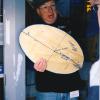Lagrangian Points
Louis LaGrange in the later part of the 18th century was attempting to solve the famously difficult the Many Body Problem - predicting the orbits of multiple objects. We now know that this problem is insoluable except by approximation. LaGrange did discover that the problem could be partially solved for three bodies as long as two were huge compared to the third. For example the two large bodies might be the Earth and the Moon and the tiny body might be a spacecraft. In so doing he discovered there were places where the tiny body was precisely balanced by the two large bodies.
The most obvious place is between the two large bodies at the point where the gravity of the two huge bodies balance each other. In the case of the Earth and the Moon this is about 3000 miles above the Moon's surface in the direction of the Earth. This point is called LaGrangian Point 1 or simply L1. LaGrange also discovered that a point on the far side of the Moon was also a point where the spacecraft balanced - L2. Yet a third point is on the far side of the Earth opposite the Moon - L3. Two other points in the Moon's orbit 60 degrees ahead and behind the Moon are balance points L4 (leading) and L5 (trailing).
A similar situation occurs with Jupiter and the Sun. The L4 and L5 points for Jupiter have acted as collection points where meteors, old comets and asteroids have collected. These objects swarm around the centers of the L4 and L5 points. They can be easily seen by telescopes from Earth.
The LaGrangian points are not equivalent. L4 and L5 are called stable LaGrangian points. Think of them something like a "bowl shape". No matter which direction a marble is nudged in the bowl, it will settle down at the bottom. All sides are "up" for the L4 and L5 points.
The L1, L2 and L3 points are "saddle shaped" when it comes to gravitation. If a marble is placed on a saddle and nudged forwards (or backwards), the uphill slope of the saddle will cause the marble to roll back. But if the marble is nudged even a bit to the left or right, the marble will roll off the saddle.
In reality the bowl and saddle surfaces are simplifications because the LaGrangian Points are three dimensional volumes rather than two dimensional surfaces. For the L4 and L5 points traveling in any direction causes the spacecraft to feel the tug of gravity back towards the center. To escape the L4 or L5 points requires a substantial thrust from the spacecraft. For L1, L2, and L3 the direction aligned with the two large bodies "goes uphill" while any direction off this center line is "downhill" or an unstable direction, causing the spacecraft to escape. Eventually even the most minute graviational tugs (such as those from other planets) will cause things at the L1, L2 or L3 points to drift off.
All of this might seem highly academic but with the concern at the loss of the Hubble Space Telescope [HST] looming, it is interesting to note that its replacement the James Webb Space Telescope [JWST] may very well end up in the Earth/Sun L2 point. The Earth/Sun L2 point lies roughly a million miles farther out from the Earth on the side away from the Sun. The Earth will act as a giant shade for the JWST allowing it to function with less heating and cooling. Sunlight, either direct or bouncing off Earth's oceans cannot blind the new telescope's optics as they can do with the HST because the Sun will be hidden behind the Earth. The Earth's shadow will all the JWST to point much closer to the Sun angle than is safe for the HST. Interference from Earth's electromagnetic sources will be greatly reduced by distance.
On the downside, servicing the JWST at the L2 location is more difficult than it would be in low Earth orbit. Oddly enough, in spite of being four times as far as the Moon, it will be easier to reach the JWST for servicing at the L2 point than it would be on the surface of the Moon. The final choice of where to place the JWST will have to consider servicing and this factor alone may force it to be placed in a less advantageous place such as low Earth orbit.
- Author:
- Leslie Coleman
- Entry Date:
- Sep 1, 2004
- Published Under:
- Leslie Coleman's Columns

